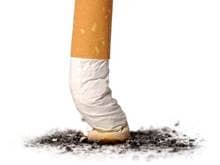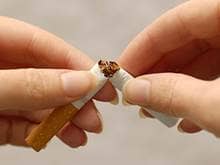You're almost there. You want to quit. In fact, 80 percent of your brain is sure you can. But 20 percent insists that you can't. How do you make it over to the other side without falling SPLAT on your face?
Do this. Make a list. Of ten reasons you should quit.
Here's mine.
1. Smoking Made Me Sick
For real. Within a few minutes of inhaling a few cigarettes, my throat would start to tickle and my head would begin hurt. The day after a binge, I'd wake up with a nasty cold that kept me in bed when I had a million things to do.
Smoking shrinks your blood vessels, clogs up your lungs, and wears down your immune system. Your body is less able to fight off bacteria and viruses, so, yes, you get sick. And there's of course the lung cancer and increased chances of heart attack, stroke, and other serious health conditions.
2. My Husband Told Me I Smelled
He didn't issue an ultimatum: "It's either me or the lung rockets."
But he did, one night right after we had sex, say, "You smell like smoke. And it's not sexy." I could have, theoretically, told him to visit a place where there are no lemonade stands. But I knew he was just being honest with me, and that I needed to file that information in the "reasons I should quit" box.
3. I Wanted to Set a Good Example for My Kids
I got tired of hiding it from them. It was getting complicated. I rationalized that smoking in front of 11-month-old Katherine was okay because she would never remember it and she would be unable to tell on me. But three-year-old David could very well process it and file the picture (and definitely debrief the rest of the house on the white candy sticks). It was too much of a risk. One day I finally said to myself, "Self, if it's so important to hide this habit from my kids, shouldn't I quit?" And there was silence.
4. I Looked Stupid Lighting Up After a Run
You can picture it, right? Here I was working so hard on my wellness
program: eating lots of greens, loading up on Omega-3 fatty acids, trying to get adequate sleep, meditating, and of course exercising five times a week. So when I'd light up after a good run, you can imagine the stares. The snapshot was like a Sesame Street episode where you have to pick out one thing that doesn't belong in the picture. That one thing was the white stick.
5. It Sent the Wrong Message
A few months after college graduation, when I was working at my first job, my mom told me to dress for the position that I wanted... to send the subtle but effective messages whenever possible. Her wisdom translated to smoking breaks. By going out of the building for a few puffs with some co-workers, I was sending a very direct message, and not the right one. So much for the nice suit.
6. I Ran Out of Money
You've probably tallied it up, and it kills you, doesn't it? Knowing how much cash you are squandering for your fix? An average pack of cigs costs about $4.50 today. Let's say you smoke a pack a day. You're throwing out $135 a month, and $1620 a year. It's a bloody expensive habit. I started to see it as babysitting money. And then it hit me. I'd much rather get a sitter and go out to a nice dinner than to be a slave to the white sticks.
7. It Made Me Depressed
Given my delicate biochemistry, I need to avoid all foods, drinks, or chemicals that make me depressed. That's essentially why I eliminated booze from my life. It's a depressant: my hangovers involved more than a headache. Smoking cigarettes can also increase the chance of developing depression. By a whopping 41 percent, according to a new study from the University of Navarra in Spain and the Harvard School of Public Health. Researchers discovered there was a direct correlation between smoking and depression among the 8,556 participants.
8. It Was Bad for My Image
I realize I'm not the perfect poster girl for mental health, but I do like to practice what I preach. So if I'm writing about my addictions with a cigarette in one hand and a brandy in the other--all while dispensing smart advice on how you all can break free of your habits--I'm going to feel like a mongo hypocrite. And that creates stress, which is bad for my mental health. So, for as long as I'm in the business of writing mental health material, I need to keep a sort-of clean image.
9. It Looks Ugly
I will always remember the sight at this elegant wedding I attended of a gorgeous bride with a cigarette in her mouth. Take away the white stick, and she could have posed for the magazine of her choice. She was petite and exquisite. Add the lung rocket, and she looked, well, like she had just been dropped off on a motorcycle to her nuptial vows. It was just not a good look at all. Not in anyway. And I started to think to myself, "Yipes. Is that what I look like when I'm smoking?"
10. I Wanted to Be Free
All addictions enslave you. They place you on their schedule, and you have no say in the matter. If you miss your afternoon smoke break, you are a wreck by the evening. There is not much you can do. You grow irritable. You need your fix. NOW.
I don't like belonging to anyone. I like to make my own rules. When I want. How I want. So because of that, I had to bid adios to my inflexible friend, to the addiction that wouldn't let me determine what I did with my afternoon.
*** Originally published on
Beyond Blue at Beliefnet.com. To read more of Therese, visit her blog,
Beyond Blue at Beliefnet.com, or
subscribe here. You may also find her at
www.thereseborchard.com.











 Want to find more tips and share the strategies that worked for you? Join the
Want to find more tips and share the strategies that worked for you? Join the